ISIS/Daesh is on the retreat in Syria, which is very good news for the people of that beleaguered country and for the world. However, the Syrian tragedy is far from over and rebuilding the country, even under the best circumstances of an end to the war, will take many years.
Our little international delegation — we were two Americans, a Canadian, two Norwegians, a Palestinian from Jordan and another Palestinian from Lebanon — got to see the evidence for this first-hand, along with the horrific devastation left in the wake of the ISIS occupation of the world-famous ancient city of Palmyra and the neighboring Syrian town of Tadmor.
The tour was arranged and led by a Palestinian organization based in Australia that is very supportive of the Syrian government and it was facilitated by the Syrian Ministry of Tourism and other government agencies.
It took some very intense negotiations with the Syrian authorities to secure visas, especially for the Americans, who are understandably viewed with some suspicion given the very hostile policies toward Syria by the US government. Even more complicated efforts were necessary to get permission – from the Syrian security agencies, the Ministry of Defense and the Russian military mission in Syria – to visit Palmyra, which was only recaptured by the Syrian army on March 26. We were the very first group of international civilians to view the site and the aftermath of the battle that took place there.

Even with permission, traveling to Palmyra was not easy. Because the direct route northeast from Damascus was not yet safe, it was necessary to travel first due north to Homs and then east across the desert along a road only recently cleared of armed rebels. Even exiting Damascus required a detour to the west in order to avoid a dangerous stretch of highway threatened by fighters in the rebel-controlled town of Douma, just north of the capital.
There were also frequent military checkpoints along the way, at each of which Qusay (everyone here is identified only by first name), our liaison with the government, had to negotiate passage and show various documents and permissions – along with our passports. The drive to Palmyra, which in peacetime would have taken maybe two hours on the direct route, took us six hours to complete.
Even in the tense security situation, though, at least one Syrian officer at a checkpoint on the outskirts of Damascus had not lost his sense of humor. When told that we were an international group on the way to visit Palmyra, his parting words after checking our documents was “Say hello to Zenobia!” He was referring to Zenobia, the famous queen of Palmyra who led a doomed revolt against the Roman Empire in the third century AD and has been adopted – quite ahistorically — as a kind of early freedom fighter and Syrian national heroine.
In Homs we picked up or military escort, Colonel Sameer, who packed a Makarev in a shoulder holster and carried a gym bag inside of which it wasn’t hard to make out the bulges of a Kalashnikov assault rifle and a bunch of grenades. Comforting.
With Colonel Sameer riding shotgun, it was relatively simple to negotiate the frequent military stations and roadblocks along the rest of the way to Palmyra. As we approached the city we observed increasing signs of war damage – bullet-pockmarked and partially destroyed buildings, down electrical transmission pylons, burned out vehicles – but nothing prepared us for the utter devastation of the town of Tadmor/Palmyra when we arrived.
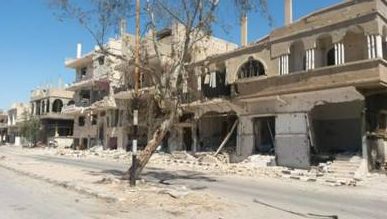
The place had suffered both from the Daesh occupation and even more so from the fighting to retake it. There was hardly an undamaged building to be seen and although the rubble blocking the streets had largely been cleared, there were many areas where only the skeletons of destroyed buildings remained. And the retreating Daesh fighters had left the town and the ruins riddled with mines and booby traps which took a huge effort, not yet completed, to disarm. Most of the inhabitants had fled the Tadmor/Palmyra when it was taken over by Daesh last summer.
When we visited last Sunday, the town was crowded with busloads of former residents collecting their personal possessions and household furnishings to take away on buses and trucks. Only in the previous few days, weeks after retaking the town and extensive de-mining, was it possible for any of them to return safely in order to retrieve some of their surviving belongings. But the town was still uninhabitable for civilians due to the severe damage and the lack of electricity or water.
The streets were guarded by soldiers and the somewhat more ragtag National Defense Forces militia fighters in various stage of partial uniform.
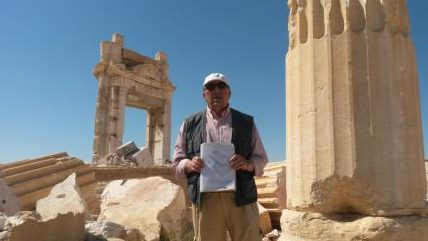
The systematic vandalism and destruction by Daesh at the historic archaeological site of Palmyra has been widely reported, but viewing the damage was still a shock. Our cultural guide Antoine (“Tony”), who had led countless groups to visit the Palmyra, was brought to tears. Ya haram (“shameful”), he muttered repeatedly as we saw the remains of the formerly well-preserved monumental archway leading into the ancient city and the Temple of Baal which the Daesh fighters had blown up when they took the city last summer.
Only the remains of the theater had been left untouched, possibly as a monument to the brutal execution of 25 captive Syrian army prisoners that Daesh had carried out and filmed there.
We had to wait a while before entering the theater ourselves because there was a high-ranking group of Russian military officers visiting inside when we arrived. Accompanying them was a contingent of very steely-eyed special forces soldiers, despite the heat, in full battle gear – body armor, helmets, boots and gloved hands with fingers poised close to the triggers of their automatic weapons.
There is a contingent of Russian military engineers and technicians engaged in the ongoing effort to disarm mines and booby traps it the city and among the ruins, with a large camp just outside the town. Near the ruins is a former restaurant whose red sign announces, in Cyrillic and English, that it is the “Sappers Café.” While we toured the site, explosions could be heard at regular intervals nearby and we could see the smoke of detonated mines.
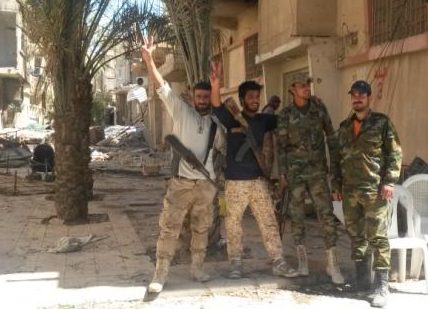
When the officers and their guards exited the theater, our group leader Khaled, who like many Palestinians of his generation had received scholarships to study in the old Soviet Union (Leningrad, in his case), enthusiastically greeted the soldiers in fluent Russian, somewhat to their surprise. Colonel Sameer had earlier told us that we could photograph anything we wanted – except the publicity-shy Russians. Given the cordial chitchat with Khaled, I thought I might ask if I could take a picture. The Russian translator answered, to everyone’s amusement, with an emphatic monosyllable — NYET.
What does the future hold for Syria?
Nearly everyone we met – and they were by no means all uncritical supporters of the Assad regime – told us that they believed any hope required, first of all, the defeat of the armed rebels and an end to foreign intervention in their country. This was especially the sentiment of Christian and Druze religious representatives, along with ethnic minorities and secular people of any faith background, who together undoubtedly comprise a majority of the Syrian population.
Regardless of the legitimate grievances at the root of the crisis which began in 2011, and even if the opposition may not all be “terrorists,” as the Assad regime charges, the armed rebels now overwhelmingly represent Sunni fundamentalists of various stripes, whose vision for Syria is a religiously exclusive Islamic state, not a secular democracy. This is true of the so-called “moderate” opposition which the US and its allies are arming and financing, not only the recognized extremists and foreign fighters in ISIS/Daesh and the Nusra front.
Amid the destruction and despair of the current situation in Syria, there are also signs of hope and resilience. In central Damascus the shops and restaurants are open, even if the hotels remain nearly empty. In the Old City Bab Touma neighborhood where we stayed – especially since the partial cease-fire agreement that was established earlier this year has minimized the rebel mortar and rocket attacks – the streets were crowded with students and shoppers, even if there were also military checkpoints along the major streets and at the gates to the town. There was a vibrant nightlife at many cafes and eating places, often with live music and diners who took to enthusiastic and spontaneous dancing and singing along to the musicians.
In the midst of the near total destruction in the old city of Homs, which was under rebel control and the scene of intense fighting until 2014, the historic Khaled Ibn Walid mosque, heavily damaged in the fighting, is now the site of a major restoration project. But a hundred thousand new housing units will also be required to replace what was destroyed.
In another part of the city, not far from where the courageous Dutch Jesuit Frank van der Lugt was murdered by the retreating rebels, the vandalized Syrian Orthodox Notre Dame de la Ceinture de Marie is also undergoing restoration. Across the street, one of the few re-opened shops is a café filled with young men and women – a circumstance unthinkable in zones under rebel control. On the wall is a statement of hope, along translation of some famous lines by the famous Palestinian poet Mahmoud Darwish, who is also revered by Syrians:
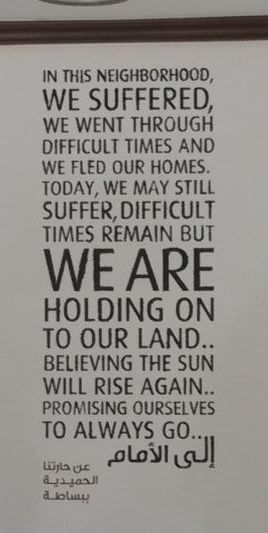

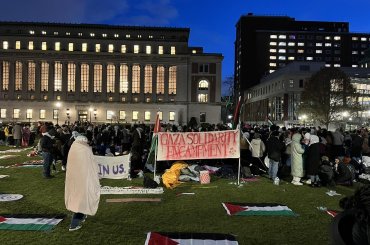
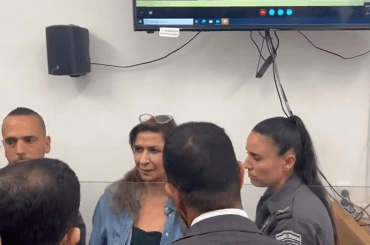
Let’s see you try to blame Israel for this one
How is it different from Muslim Waqf’s destruction of Jewish artifacts on the Temple Mount?
How does this tour differ from a tour of Gaza taken with Israeli soldiers where you hear from them and others about how the key to peace is defeating Hamas and Palestinian armed factions?
The idea that a tour with the backing of the Syrian regime and accompanied by the Syrian military can be called a peace delegation is really problematic. The idea that the government, which is responsible for more deaths than any other party in Syria, is an acceptable interlocutor for “leftists” is really problematic. The idea that you can call for liberation and peace in Syria by calling for the defeat of all groups opposed to the regime is really problematic.
I’m no supporter of Western intervention and am not uncritical of opposition groups in Syria. However, Syrian regime led a brutal police state before all of this started and the government was the initiator of violence when it brutally cracked down on protesters calling for their rights. It is the government of Syria which has dropped barrel bombs on its population, starved civilians, tortured people, executed people, etc. It has not carried out brutality in a way that is publicized like the violence of ISIS, but really it doesn’t make a lot of difference. If you cut off five people’s heads on camera like ISIS or shoot ten people in the head off of camera like the regime the result is the same. Dead people and terrified populations.
Again, I’m no supporter of US policy in the Middle East and am not saying this to support another faction of US action. I certainly don’t support US intervention. However, apologies for brutal regimes do not belong on a website that is supposedly dedicated to rights and liberation.
excellent report …thank you jeff!
as to role of israel (see other comment) ….
there is some faulty analysis which claims israel is not involved. baloney.
the role is largely hidden but huge.
hillary clinton as secy of state issued her ultimatums to assad in 2010.
her demands all pertained to zionist israel goals and interests (NOT us).
it is well documented that zionism seeks to destabilize and divide arab states.
i look forward to seeing more reports from on the ground in syria by jeff.
This article is awful
That someone would go on an Assad tour of Syria after the release years ago of the “Hannibal” photos showing industrial scale regime murder or the chemical gassing of 1300 in Ghouta is behind belief.
This was no “peace” tour. See the group cheerfully with their arms around Assad soldiers and extending V signs on the tour’s Facebook page. They were embracing his forces.
https://www.facebook.com/International-Tours-of-Peace-to-Syria-454873351281581
Klein write, “Nearly everyone we met – and they were by no means all uncritical supporters of the Assad regime – told us that they believed any hope required, first of all, the defeat of the armed rebels and an end to foreign intervention in their country.”
–Who do you think you met except hand picked people? Ever go to the Soviet Union and meet all those people in love with Stalin or Brezhnev government?
“In the midst of the near total destruction in the old city of Homs, which was under rebel control and the scene of intense fighting until 2014 …”
–And it was blown up by the Assad-Russian airforce. Even Patrick Cockburn who supports Assad as a lesser evil admits Assad’s troops blow up everything they can’t control. Take a look at the utter destruction in the video shot by the Russian drone.
“the armed rebels now overwhelmingly represent Sunni fundamentalists of various stripes”
–I don’t think you have a clue here. The “rebels” are mainly 1,000 different local militias without any ideology, just trying to save themselves from mass rape, torture and murder from Assad, from ISIS.
I’m surprised Mondoweiss would print this piece. Why not a piece on the extermination of Palestinians and Syrians in Yarmouk? ISIS appears to be finishing off the Palestinians with cooperation of Assad forces according to Nidal Bitari.